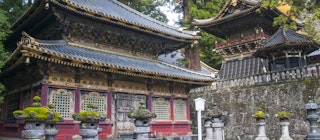Tōshō-gū
 |
| Image by Philip Game Getty Images |
A Unesco World Heritage Site in an idyllic natural setting, Tōshō-gū is a lavishly ornate Shinto complex within which Tokugawa Ieyasu (1543-1616), the first shōgun and founder of the Tokugawa Bakufu (Japan's last feudal military government) is enshrined. Among its standout structures is the dazzling 'Sunset Gate' Yōmei-mon, a five-storied pagoda and the grand Honji-dō with its famous 'crying dragon'. Most of what you see was commissioned by Ieyasu's grandson in 1636.
Sections of the shrine may be closed for repairs until 2020.
The stone steps of Omotesandō lead past the towering stone torii (entrance gate), Ishi-dorii, and the Gōjūnotō, an 1819 reconstruction of the original mid-17th-century pagoda, to Omote-mon, Tōshō-gū's main gateway, protected on either side by Deva kings.
In Tōshō-gū's initial courtyard are the Sanjinko; on the upper storey of the Kamijinko (upper storehouse) are relief carvings of 'imaginary elephants' by an artist who had never seen the real thing. Nearby is the Shinkyūsha, adorned with relief carvings of monkeys. The allegorical 'hear no evil, see no evil, speak no evil' simians demonstrate three principles of Tendai Buddhism.
Further into Tōshō-gū's precincts, to the left of the drum tower, is Honji-dō, a hall known for the painting on its ceiling of the Nakiryū (Crying Dragon). Monks demonstrate the hall's acoustic properties by clapping two sticks together. The dragon 'roars' (a bit of a stretch) when the sticks are clapped beneath its mouth, but not elsewhere.
Restored in 2017, the Yōmei-mon dazzles with its gold leaf and delicate carvings of flowers, dancing girls, mythical beasts and Chinese sages. Worrying that the gate's perfection might arouse envy in the gods, those responsible for its construction had the final supporting pillar placed upside down as a deliberate error.
Gōhonsha, the main inner courtyard, includes the Honden (本殿; Main Hall) and Haiden (拝殿; Hall of Worship). Inside these halls are paintings of the 36 immortal poets of Kyoto, and a ceiling-painting pattern from the Momoyama period; note the 100 dragons, each different. Fusuma (sliding door) paintings depict a kirin (a mythical beast that's part giraffe and part dragon).
To the right of the Gōhonsha is Sakashita-mon, into which is carved a tiny wooden sculpture of the Nemuri-neko that's famous for its lifelike appearance (though admittedly the attraction is lost on some visitors). From here it's an uphill path through towering cedars to the appropriately solemn Okumiya, Ieyasu's tomb.
Bypassed by nearly everyone at Tōshō-gū is the marvellous Nikkō Tōshō-gū Museum of Art in the old shrine offices, showcasing fine paintings on its doors, sliding screens, frames and decorative scrolls, some by masters including Yokoyama Taikan and Nakamura Gakuryo. Follow the path to the right of Omote-mon to find it
Belum ada Komentar untuk "Tōshō-gū"
Posting Komentar